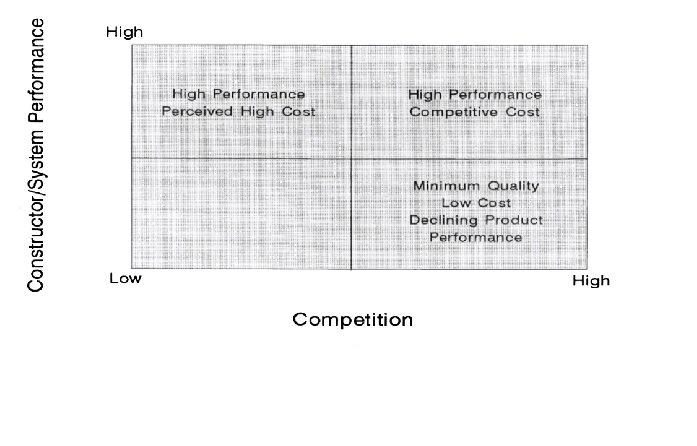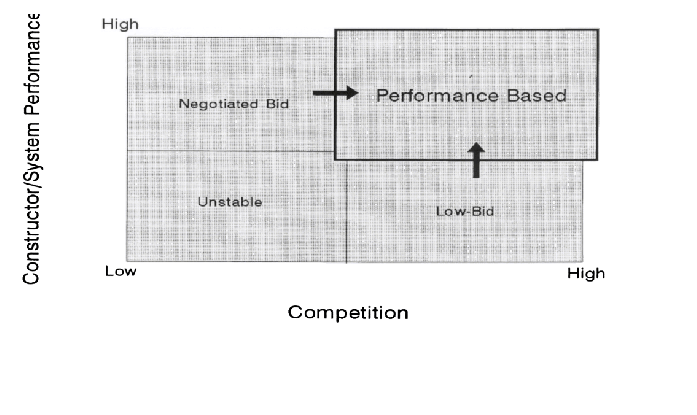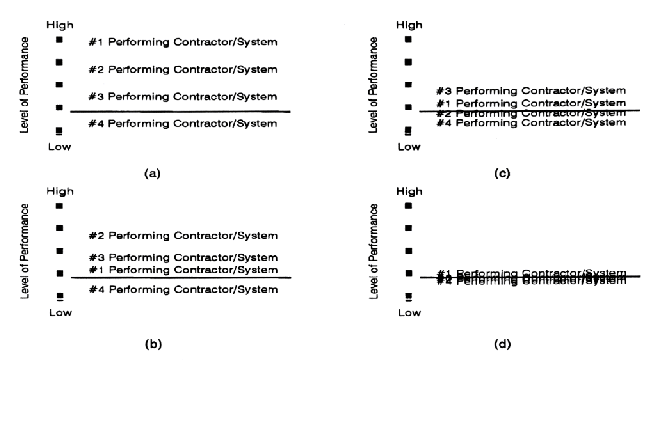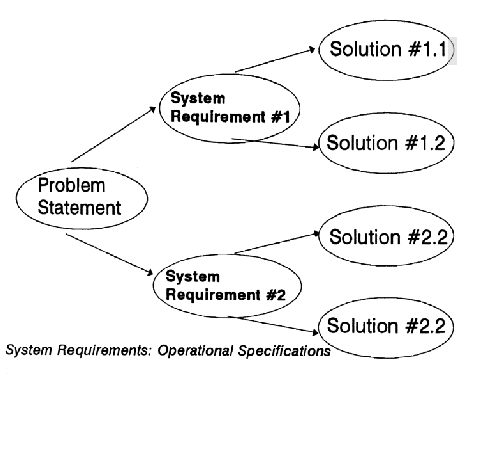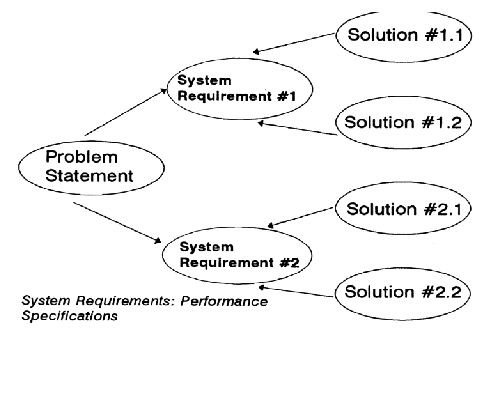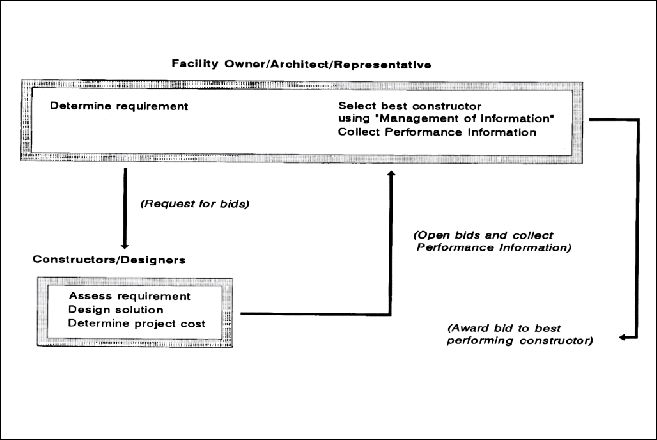|
(pressing HOME will start a new search)
|
|
Using Fuzzy Logic and the Management of Information To Increase the Performance of Construction Systems
Dean
T. Kashiwagi
Del
E. Webb School of Construction
Arizona
State University
Tempe,
Arizona
|
This paper introduces the research work of the Performance Based Studies Research Group (PBSRG), the Alliance of Construction Excellence (ACE) and the Del E. Webb School of Construction (DEWSC) to apply a new delivery mechanism for construction systems, to increase the performance of the construction systems and the stability of the construction industry, and to assist manufacturers, suppliers, and constructors perform continuous improvement on their construction products. The research is based on "fuzzy thinking," the management of information, and the education of constructors and facility owners on the concepts of industry stability. Concepts utilized include "fuzzy logic" philosophy, "backward chaining" solution methodology, and a relative distancing model to evaluate alternative solutions and to procure the best available facility system. Participants in the program include general contractors, Job Order Contractors, mechanical contractors, roofing contractors, material suppliers and manufacturers, and facility owners and managers from Motorola, Honeywell, Morrison Knudson, IBM, and from other major facilities in the Phoenix metropolitan area. |
Introduction
There
is a requirement in the construction industry and facility management arena to
increase facility system performance and reduce the risk of premature
replacement and maintenance and operational costs. Facility managers have
traditionally used specifications and the "low bid" competitive award
to attempt to minimize the cost of facility systems. The emphasis on cost has
placed the construction industry in a dilemma of improving construction and
facility system performance while reducing costs. The lack of a method to
differentiate performance of constructors and their construction systems in a
"low bid" environment has resulted in a decline of construction
product performance. Facility owners, manufacturers and contractors of
performing construction systems have identified a requirement for a new design,
procurement, and construction delivery System which integrates performance
information to deliver the "best available" performing contractors and
systems for the most economical cost.
Declining
Construction/Facility System Performance
The
author (Kashiwagi:1991) modified a Hrebeniak and Joyce (1985) environmental
determinism model into an "Industry Stability" model (Figure 1) and a
"Low Bid Performance" model (Figure 2) to explain why the current
industry structure and the competitive "low bid" award delivery system
leads to a gradual trend toward minimal performance and lower performing
construction products. "Industry stability" is defined as the ability
of an industry to continually produce and improve a performing construction
product (Kashiwagi:1994). Using the "Low bid" minimum specifications
result in high competition and minimal standards (Quadrant 1 in Figure 1).
Facility owners in both Quadrants 1 and 3 seek to move to the Performance Based
Quadrant, either due to increased pressure to seek a higher level of performance
or more competition. In both Quadrants 1 and 3, the perception is that
performance is not being maximized. The author (1994) has defined "industry
stability" as the relative size of the Performance Based Quadrant in
relation to Quadrants 1 and 3. This is deducted due to the influence of the
performing construction systems on the rest of the industry.
|
|
|
Figure
1. Construction Industry Structure |
The
first chart in Figure 2 shows four contractors with varying degrees of
contractor/installed system performance. The top contractor is the highest
performing contractor and #4 is the poorest performing contractor. The
assumption made by the author is that contractor/system performance is related
to investment and cost to the contractor. The minimum specification line is
drawn between contractors #3 and #4. In this example, contractor #4 does not
meet the minimum specification level of performance and cannot bid on the
contract. As shown in the first chart, contractor #3 will be awarded the
project. To become competitive, contractor # 1 drops the level of performance
(and accompanying cost). In the second chart, contractor #1 is now the most
competitive. Contractor #2 becomes more competitive in the third chart, dropping
very close to the minimum performance requirements, thus securing the bid.
Figure 2 shows the performance and cost of the contractors gravitating toward
the minimum levels of performance set by the facility owner. This scenario leads
to the following conclusions:
|
|
|
Figure
2. Construction Industry Stability |
1.
The "low bid" award process assumes that all alternatives are
equal in performance except for the cost.
2.
Facility owners define performance, and the contractors regulate
performance to meet the requirements of the facility owners.
3
The "low bid" award delivery system does not give the
constructors incentives for long range continuous improvement of product and
performance.
The
PBSRG used the above conclusions to shape a research program that performs the
following:
1.
Define performance of construction systems.
2.
Collect performance information.
3.
Use the author's performance based procurement system (PBPS) to evaluate
and procure construction systems.
4.
Use performance information to assist manufacturers and contractors
improve their performance.
5
Use performance information to assist facility owners minimize risk and
cost.
Forward
and Backward Chaining
Facility
owners currently use "forward chaining" to meet facility system
construction requirements. The facility owner or representative first analyzes
the problem resulting in several possible solutions. An alternative solution is
selected and specification created. A key point is that a specific facility
owner and his representative may not consider all possible alternatives. The
constructors who can deliver the specified systems then bid on the project, and
the qualified low bidder (constructor L 1 in Figure 3) is awarded the contract.
The drawback to this "forward chaining" process is that alternative
#3.3 in Figure 3 was the best performing contractor/system.
|
|
|
Figure
3. Results of Low Bid Process |
The
specification/low bid procurement process is a forward chaining solution process
that does not result in high performance. Kashiwagi (1994) identified that a
backward chaining solution process was much more efficient in producing high
performing constructor/facility system performance (Figure 4). He stated that in
situations where facility owners could easily define the requirement, they
should use the management of information, fuzzy logic, and backward chaining to
select the best performing contractor and installed facility system.
|
|
|
Figure
4. Forward Chaining |
Performance
Based Procurement Process (PBPS)
The
author developed and tested the PBPS in 1991 and did further refinements and
testing of the PBPS in 1993 1994. The author has collected performance
information on industrial roofing systems for the past 12 years from 2,000 roofs
in the United States and Europe. The first seven tests of the PBPS utilized
roofing performance information. The PBPS process is shown in Figure 5. It
includes the following steps:
1.
The facility owner identifies the requirement.
2.
Constructors/designers propose alternative solutions, with accompanying costs
and previous installations where they have implemented the proposed solution.
3.
Performance data is collected on the alternative solutions.
4.
A "fuzzy logic" relative distancing model is used to compare the
alternatives and select the best constructor/facility system proposal.
|
|
|
Figure
5. Backward Chaining |
The
process can either be used as a pre-qualification or a one step competitive best
bid delivery system. The system is inherently a continuous improvement system
driven by information and thereby automatically pre-qualifies based on
performance information.
“Fuzzy
Thinking”
"Fuzzy
thinking" is differentiated from traditional stochastic and parametric
analysis by its simplistic method of "relativity." It uses the
following tenants (Kosko:1994, Kashiwagi:1994):
1.
Deterministic environment.
2.
Every relationship or description is relative.
3.
It is more efficient to describe a relative measurement of the relationship
rather than to accurately quantify the actual relationship.
Research
projects utilizing the PBPS show that unless the facility owner requirements and
construction system data are dependent. This is reinforced by the concept of
"relativity" in "fuzzy logic" and leads to the following
conclusions:
1.
Facility owner requirements cannot be predetermined.
2.
Performance information is dependent with owner requirements.
The
relative distancing model used is the "Displaced Ideal Model" (DIM)
introduced by Zadeh (1982). The DIM is used instead of the Analytical
Hierarchical Process (AHP) for the following reasons:
1
It is much more simplistic and easier to run.
2
It does not predetermine whether a weight scheme is correct.
3
It is less time consuming to run a large number of iterations.
4
It concentrates on prioritization of alternatives and identifying the
performance requirement rather than the consistent weighting required for
pairwise comparison in AHP.
5
DIM is more adept to assisting continuous improvement.
The
PBPS is currently being run using off-the-shelf windowing software including a
database, spreadsheet, and server interface. The software generates performance
lines and allows the facility managers to weight the performance criteria to
generate facility system requirements (Figure 6). Performance criteria include
"combined performance criteria" which represent performance to
facility managers. For example, one criteria represents the capability of a
roofing contractor to install large roofs that do not leak, that satisfy the
customer, and perform for an extended period of time. The repeated
identification of roofing performance produces:
|
|
|
Figure
6. Performance Based Procurement System |
1.
An environment that can optimize contractor operation and material
selection.
2.
Identification of roofing performance.
3.
An artificially intelligent system which can reproduce the decision
making process of experienced facility managers.
Performance
Information
As
defined previously,
performance information is defined by the facility owner. The following criteria
is used on roofing requirements:
1.
Proven performance period.
2.
First cost and equivalent uniform annual costs.
3.
Percent of roofs not leaking.
4.
Percent of roofs not requiring maintenance.
5.
Customer satisfaction.
6.
Amount of traffic on a roof.
7.
The amount of disturbance to the facility operations caused by the roof
installation.
The
facility owner's requirement is composed of a weighted scheme that prioritizes
the performance criteria. This scheme is dependent with the actual performance
information, requiring an iterative process to arrive at the final weighted
scheme. By its inherent structure, the PBPS fulfills the requirements of
construction "industry stability" which include:
1.
Setting up entry/exit barriers.
2.
Allowing the constructor to receive a fair profit.
3.
Does not tolerate poor performance.
4.
Encourages the constructors to do continuous improvement.
5.
Allows total competition with no pre-qualification.
6.
Gives the facility owner buyer protection.
Testing,
Refining, Results
The
PBPS has run seven times in 1994. Roofing constructors and installed roofing
systems were procured six times. The seventh running procured a janitorial
service. The roofing procurements were in Phoenix, Arizona (3), Tucson, Arizona
(1), Indianapolis, IN (1), and Arlington Heights, IL, (1). The janitorial
service was procured in Arlington Heights, IL. The PBPS was run for Motorola,
Indianapolis Community Hospitals, and Morrison and Knudson (facility manager for
IBM and the University of Arizona). The PBPS was also run for a facility manager
of a large electronics manufacturing company in the Phoenix, metropolitan area
who desired to remain anonymous.
The
major conclusions from the roofing procurements were
1.
In five out of the six procurements, the facility managers selected
roofing contractors and roof systems that they did not previously know about.
2.
In one of the PBPS, the facility manager selected a roof system type
(single ply) which they had poor previous performance.
3.
In five PBPS’s, the facility managers procured the best available
performing roofing system for a lower price than if they had used a
specification and taken the low bidding constructor. The savings ranged from
x.30/SF (30,000) to X2.00/SF 0200,000), considering only first cost.
4.
In four out of the six cases, the low bidder was not selected.
5.
Collection of the performance information can be accomplished in two
weeks for 300 data points.
6.
The facility managers were all very comfortable with the selection of the
contractors using the PBPS and performance information. Different facility
managers have different facility requirements and the "best available"
roof system is defined by the requirements of the facility owner.
7.
A couple of the facility managers were so impressed with the identified
best performer that they have intentions to use the contractor for previous work
without rerunning the PBPS.
8.
Manufacturers and contractors are currently doing continuous improvement
to increase their system performance and competitiveness.
Conclusions/Recommendations
The
Performance Based Procurement Process is a fully automated, information
managing, continuous improvement tool which will select the best performing
contractors which results in construction industry stabilization and the
optimization of facility management funding. The PBPS cuts costs, increases
performance, forces continuous improvement, and uses the latest techniques of
the management of information, backward chaining, "fizzy logic," and
artificial intelligence. The PBPS also redefines construction industry
participants roles to maximize performance. It is easier to use, fully
competitive, and reduces the time to procure.
The
PBPS is being used by the Performance Based Studies Research Group at the Del E.
Webb School of Construction at Arizona State University to also identify
performances of general contractors, Job Order Contractors, mechanical
contractors, and facility managers. The author has approached and discussed the
use of Performance Based Procurement with facility managers from Honneywell, GM,
and other major manufacturing groups to test the system in 1995. The PBPS will
be run a minimum of six times in 1995. Another goal is to run the system out in
a government procurement test. The author has applied for a patent on the PBPS
and the computer application.
References
1.
Hrebiniak, L.G. and W.F. Joyce, (1985), "Organizational Adaptation:
Strategic Choice and Environmental Determinism." Administrative Science
Quarterly, 30, 336-349.
2.
Kashiwagi, Dean T., (1991), "Development of a Performance Based
Design/Procurement System for Nonstructural Facility Systems." Arizona
State University, Tempe, AZ.
3.
Kashiwagi, Dean T., (1994). Unpublished notes from "Performance
Based Evaluation/Facility Management" Continuing Education course,
Performance Based Studies Research Group, Del E. Webb School of Construction,
College of Engineering, Arizona State University, Tempe, AZ.
4.
Kashiwagi, Dean T., Nuno, J. Pablo, and Moor, William, C,
"Optimizing Facility Maintenance Using Fuzzy Logic and the Management of
Information,16th International Conference on Computers and Industrial
Engineering, March 7-9, 1994, Ashikaga, Japan, 404407.
5.
Kashiwagi, Dean T., and Ryan, Scott, (1994), Unpublished report
"Stability of the Arizona Construction Industry."
6.
Kosko, Bart (1993), "Fuzzy Thinking, The New Science of Fuzzy
Logic." Hyperion, New York, New York.
7.
Zeleny, M., (1982), Multiple Criteria Decision Making. New York: McGraw
Hill.
